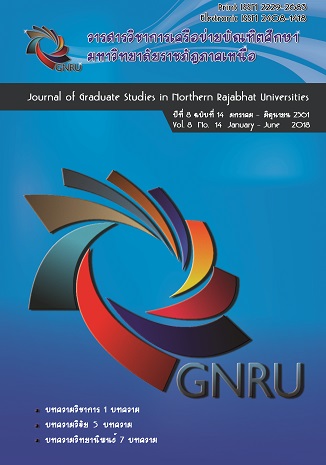รูปแบบการประเมินผลเพื่อการเรียนรู้ด้วยการประเมินเสริมพลังสำหรับครูในโรงเรียนสังกัดสำนักงานเขตพื้นที่การศึกษาประถมศึกษานครราชสีมา เขต 5
Main Article Content
บทคัดย่อ
การวิจัยครั้งนี้เป็นการวิจัยและพัฒนา มีวัตถุประสงค์เพื่อ 1) ศึกษาปัญหา สภาพและความต้องการในการประเมินผลเพื่อการเรียนรู้ของครู 2) สร้างรูปแบบการประเมินผลเพื่อการเรียนรู้ด้วยการประเมินเสริมพลังสำหรับครู 3) ทดลองใช้รูปแบบการประเมินผลเพื่อการเรียนรู้ด้วยการประเมินเสริมพลังสำหรับครู 4) เพื่อประเมินรูปแบบการประเมินผลเพื่อการเรียนรู้ด้วยการประเมินเสริมพลัง โดยศึกษากับครูคณิตศาสตร์ ในโรงเรียน สังกัดสำนักงานเขตพื้นที่การศึกษาประถมศึกษานครราชสีมา เขต 5
ผลการวิจัยพบว่า
- ครูมีปัญหา การไม่เข้าใจการประเมินผลเพื่อการเรียนรู้ สภาพการปฏิบัติงานการประเมินผลเพื่อการเรียนรู้อยู่ในระดับปานกลาง ความต้องการการประเมินผลเพื่อการเรียนรู้อยู่ในระดับมากที่สุด และครูมีความต้องการประเมินผลเพื่อการเรียนรู้ สูงกว่าเกณฑ์ร้อยละ 70 อย่างมีนัยสำคัญทางสถิติ
ที่ระดับ .05 - รูปแบบการประเมินผลเพื่อการเรียนรู้ด้วยการประเมินเสริมพลังสำหรับครู ประกอบด้วยขั้นวางแผน ขั้นประเมินระหว่างดำเนินการสอน ประกอบด้วย 3 ขั้นตอน ได้แก่ ประเมินสำรวจรู้ ประเมินกระตุ้นความคิด และประเมินสะท้อนผล ขั้นสรุปเพื่อนำผลการประเมินไปปรับปรุง ควบคู่
ไปกับการประเมินเสริมพลังครู โดยครูพัฒนาตนเองปฏิบัติตามขั้นตอน 1) วิเคราะห์ทบทวนภาพงาน 2) กำหนดเป้าหมาย 3) คัดสรรกิจกรรม 4) พัฒนาแผนการจัดการเรียนรู้ และ 5) ประเมินความสำเร็จผู้เชี่ยวชาญ มีฉันทามติว่ารูปแบบถูกต้องและเหมาะสม - ผลการทดลองใช้รูปแบบมีการประเมิน ด้านการวางแผน ด้านกระบวนการ ด้านผลผลิต อยู่ในระดับมาก
- ผลการประเมินรูปแบบการประเมินผลเพื่อการเรียนรู้ด้วยการประเมินเสริมพลัง ความเป็นประโยชน์ ความเป็นไปได้ ความเหมาะสม และความถูกต้อง อยู่ในระดับมากทุกด้าน
This research aims to develop in order to 1) study of the problems, conditions, and teachers’ needs in learning evaluation, 2) create the teachers’ assessment models, 3) use the assessment models, and 4) evaluate the evaluation model for learning by using empowerment assessment for teachers by studying with mathematics teachers under Nakhon Ratchasima Primary Educational Service Area Office 5.
The research found that:
- The teachers have the difficulty understanding the evaluation for learning. The performance of learning evaluation was at a moderate level. Needs assessment for learning was at the highest level. Thus, teachers need the evaluation for learning higher than 70% at .05 level of significance.
- The evaluation model consisted of a diagram of the relationship between learning assessment and teacher empowerment assessment. It includes planning, analyzing, designing and defining, evaluating methods, analysis and criteria for self-assessment.
The teacher assesses the students about knowledge assessment, stimulate critical thinking assessment and reflective assessment, then improves the management of the next teaching.
It is intended to motivate teachers’ evaluation by self-development, which follow the procedure as 1) analyzing the work, 2) targeting, 3) selecting activities, 4) Developing a learning management plan, and 5) achieving the dimensions, tasks, dimensions, processes, and dimensions, which suitability of experts have a consensus for the correct and appropriate format. - The results of the evaluation form were divided as planning and producing was at a high level.
- Evaluation results of evaluation model revealed that the usefulness, feasibility, appropriateness, and accuracy were at high level.
Article Details
เอกสารอ้างอิง
ไตรรงค์ เจนการ. (2549). การประเมินผลเพื่อการเรียนรู้ (Assessment for Learning). กรุงเทพฯ: กลุ่มส่งเสริมการเรียนการสอนและประเมินผล สำนักวิชาการและมาตรฐานการศึกษา.
สถาบันส่งเสริมการสอนวิทยาศาสตร์และเทคโนโลยี (สสวท.). (2555). ยุทธศาสตร์ 5 ปี. สืบค้นเมื่อ 17 มกราคม 2558, จาก http://www.ipst.ac.th/web/index/php.
สวัสดิ์ชัย ศรีพนมธนากร. (2549). การพัฒนารูปแบบการประเมินเสริมพลังสำหรับการประเมินระบบการวัดและประเมินผลการเรียนรู้ในสถานศึกษาขั้นพื้นฐาน. ปริญญาการศึกษาดุษฎีบัณฑิต. มหาวิทยาลัยนเรศวร, พิษณุโลก.
สุวิมล ว่องวาณิช. (2550). การประเมินผลการเรียนรู้แนวใหม่. กรุงเทพฯ: โรงพิมพ์แห่งจุฬาลงกรณ์มหาวิทยาลัย.
องอาจ นัยพัฒน์. (2553, มกราคม-มิถุนายน). การวัดประเมินในชั้นเรียน: วิวัฒนาการและแนวคิดใหม่เพื่อพัฒนาการเรียนรู้. วารสารศรีนครินทรวิโรฒวิจัยและพัฒนา (สาขามนุษยศาสตร์และสังคมศาสตร์). 2(3), 1-11.
Fetterman, D. M. (1997). Empowerment evaluation and accreditation in higher education. In Chelimsky, E. and hadish, W. R., (eds.). Evaluation for the 21st. Century: A Handbook. p. 381-395. Sage Publication, Inc.
Stiggins, R. J. & Chappuis, J. (2012). An introduction to student involved assessment for learning. Boston, MA: Pearson.


